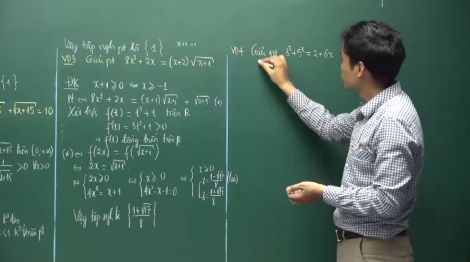Các dạng câu hỏi quen thuộc trong đoạn văn:
- Câu hỏi về thông tin chi tiết trong bài
- Câu hỏi ám chỉ
- Câu hỏi với NOT (thông tin không đúng, không được đề cập)
- Câu hỏi về từ vựng
- Câu hỏi về nội dung chính
 Playlist:
THPT QG Tiếng Anh - Chuyên đề luyện...
Playlist:
THPT QG Tiếng Anh - Chuyên đề luyện...
-
Video liên quan
-
Nội dung
-
Bài 1: Tìm khoảng đơn điệu của hàm số

Bài 1: Tìm khoảng đơn điệu của hàm số
Bài giảng sẽ giúp các em nắm được kiến thức cơ bản về cách tìm khoảng đơn điệu của hàm số như: Định nghĩa Điều kiện đủ để hàm số đơn điệu Các bước tìm khoảng đơn điệu của hàm số00:55:29 5168 TS. Phạm Sỹ Nam
-
Bài 2: Tìm tham số để hàm số đơn điệu trên một miền

Bài 2: Tìm tham số để hàm số đơn điệu trên một miền
Bài giảng sẽ giúp các em nắm được kiến thức cơ bản về cách tìm tham số để hàm số đơn điệu trên một miền như: Công thức tính. Điều kiện đủ để hàm số đơn điệu trên một miền.00:28:42 1080 TS. Phạm Sỹ Nam
-
Bài 3: Ứng dụng tính đơn điệu giải phương trình

Bài 3: Ứng dụng tính đơn điệu giải phương trình
Bài giảng sẽ giúp các em nắm kỹ hơn về lý thuyết và một số ví dụ cụ thể về ứng dụng tính đơn điệu giải phương trình.00:32:49 1080 TS. Phạm Sỹ Nam
-
Bài 4: Ứng dụng tính đơn điệu giải bất phương trình

Bài 4: Ứng dụng tính đơn điệu giải bất phương trình
Bài giảng Ứng dụng tính đơn điệu giải bất phương trình sẽ giúp các em nắm được lý thuyết và bài tập để các em củng cố kiến thức.00:32:29 870 TS. Phạm Sỹ Nam
-
Bài 5: Ứng dụng tính đơn điệu giải hệ phương trình

Bài 5: Ứng dụng tính đơn điệu giải hệ phương trình
Bài giảng Ứng dụng tính đơn điệu giải hệ phương trình sẽ giúp các em nắm kỹ hơn cách giải hệ phương trình, cách tìm tính nghịch biến, đồng biến về tính đơn điệu của hệ phương trình.00:29:14 946 TS. Phạm Sỹ Nam
-
Bài 6: Ứng dụng tính đơn điệu chứng minh bất đẳng thức

Bài 6: Ứng dụng tính đơn điệu chứng minh bất đẳng thức
Bài giảng ứng dụng tính đơn điệu chứng minh bất đẳng thức gồm có 2 phần nội dung chính: Lý thuyết Các ví dụ cụ thể nhằm giúp các em chứng minh được đồng biến và nghịch biến.00:43:58 1076 TS. Phạm Sỹ Nam
Contents:
- Detail questions.
- Reference questions.
- NOT questions.
- Vocabulary questions.
- Main idea questions.
1. Detail questions:
Scientists have observed that warmer temperatures in the spring cause flowers to............ .
A. die instantly
B. bloom earlier
C. become lighter
D. lose color
Plants and animals will find it difficult to escape from or adjust to the effects of global warming. Scientists have already observed shifts in the life cycles of many plants and animals, such as flowers blooming earlier and birds hatching earlier in the spring. Many species have begun shifting where they live or their annual migration patterns due to warmer temperatures.
When their habitats grow warmer, animals tend to move.......... .
A. south - eastwards and down mountainsides toward lower elevations
B. north - westwards and up mountainsides toward higher elevations
C. toward the north pole and down mountainsides toward lower elevations
D. toward the poles and up mountainsides toward higher elevations
With further warming, animals tend to migrate toward the poles and up mountainsides toward higher elevations. Plants will also attempt to shift their ranges, seeking new areas as old habitats grow too warm. In many places, however, human development will prevent these shifts. Species that find cities or farmland blocking their way north or south may become extinct. Species living in unique ecosystems, such as those found in polar and mountaintop regions, are especially at risk because migration to new habitats is not possible. For example, polar bear and marine mamals in the Arctic are already threatened by dwindling sea ice but have nowhere farther north to go.
2. Reference questions
The pronoun ' those' refer to.......... .
A. species
B. ecosystems
C. habitats
D. areas
With further warming, animals tend to migrate toward the poles and up mountainsides toward higher elevations. Plants will also attempt to shift their ranges, seeking new areas as old habitats grow too warm. In many places, however, human development will prevent these shifts. Species that find cities or farmland blocking their way north or south may become extinct. Species living in unique ecosystems, such as those found in polar and mountaintop regions, are especially at risk because migration to new habitats is not possible. For example, polar bear and marine mamals in the Arctic are already threatened by dwindling sea ice but have nowhere farther north to go.
3. NOT questions
According to the paragraph, what is NOT true?
A. All species are especially at risk.
B. Some species are especially at risk.
C. Polar animals are at risk.
D. Marine mammals are at risk.
With further warming, animals tend to migrate toward the poles and up mountainsides toward higher elevations. Plants will also attempt to shift their ranges, seeking new areas as old habitats grow too warm. In many places, however, human development will prevent these shifts. Species that find cities or farmland blocking their way north or south may become extinct. Species living in unique ecosystems, such as those found in polar and mountaintop regions, are especially at risk because migration to new habitats is not possible. For example, polar bear and marine mamals in the Arctic are already threatened by dwindling sea ice but have nowhere farther north to go.
4. Vocabulary questions
What does the word 'habitats' in the paragraph possibly mean?
A. facilities
B. living areas
C. farm land
D. culture sites
With further warming, animals tend to migrate toward the poles and up mountainsides toward higher elevations. Plants will also attempt to shift their ranges, seeking new areas as old habitats grow too warm. In many places, however, human development will prevent these shifts. Species that find cities or farmland blocking their way north or south may become extinct. Species living in unique ecosystems, such as those found in polar and mountaintop regions, are especially at risk because migration to new habitats is not possible. For example, polar bear and marine mamals in the Arctic are already threatened by dwindling sea ice but have nowhere farther north to go.
5. Main idea questions
What does the passage mainly discuss?
A. influence of climate changes on human lifestyles
B. effects of global warming on animals and plants
C. global warming and possible solutions
D. global warming and species migration
With further warming, animals tend to migrate toward the poles and up mountainsides toward higher elevations. Plants will also attempt to shift their ranges, seeking new areas as old habitats grow too warm. In many places, however, human development will prevent these shifts. Species that find cities or farmland blocking their way north or south may become extinct. Species living in unique ecosystems, such as those found in polar and mountaintop regions, are especially at risk because migration to new habitats is not possible. For example, polar bear and marine mamals in the Arctic are already threatened by dwindling sea ice but have nowhere farther north to go.





